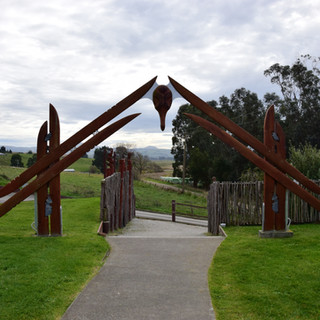Puketeraki Marae - Karitane
- Svanina O

- 18. Mai 2017
- 3 Min. Lesezeit
Haere Mai to Puketeraki Marae! Kia Ora everyone, and I hope you will enjoy reading about our visit to the Puketeraki Marae. I know it might seem a little dry, but if you want to learn a bit about Maori culture and what it is like to experience it or you have your first marae visit coming up, take the time :)
The marae is about 45 minutes north of Dunedin, where the local iwi has their meeting and cooking house, church and urupa (burial ground). Around 500 people belong to this marae, but live all over the world, coming together for big, important events.
When we arrived at the marae, we were greeted with a powhiri. So just to give you an impression of what that is like, I will try and lay out the process for you. A powhiri is the welcome ceremony to welcome manuhiri (visitors) onto the marae. The manuhiri wait outside the waharoa (gate) until the kaikaranga (woman caller) calls them onto it. They then proceed slowly towards the veranda of the whare whakairo (meeting house). Normally, the manuhiri would also have a kaikaranga, but we in this case had a man helping us out. The normal order in this is the women at the front and the men at the back. The karanga (call) continues until the manuhiri reach the porch/veranda and are invited inside. To be allowed inside you take off your shoes. Food and drinks are also not allowed inside. These are reserved for the whare kai (dining hall). Inside, the women seat at the back and the men at the front, normally behind the kaikorero (male speaker). The tangata whenua (people of the land) start the whaikorero (formal speech) with a korero (speech) and once he is done, the others get up and support his korero with a waiata (song). Afterwards the manuhiri kaikorero makes his korero and is followed by all other manuhiri with their waiata. We sang a waiata called "E toru nga mea".
E toru nga mea (there are three things)
Nga mea nui (very important things)
E ki ana (as stated in)
Te paipera (the bible)
Tumanako (hope)
Whakapono (faith)
Ko te mea nui (and the greatest thing)
Ko te aroha (charity/love)
Depending on the iwi (tribe) or even the hapu (sub-tribe) the powhiri can vary. Sometimes there is more than one kaikorero, and then it's either the tangata whenua's turn to complete all the korero and then the manuhiri's turn, or they alternate, one from tangata whenua, one from the manuhiri. This is followed by the presentation of a koha (gift/offering) to the tangata whenua who then close the whaikorero. After this, the hongi (pressing of noses) is shared between the tangata whenua and the manuhiri. This process is about sharing the breath of life with each other by pressing the noses and forehead together. This was the point when the tangata whenua's kaikorero switched to English and invited us to have some kai (food) in the whare kai.
This ended the formal process of the powhiri. So we had some light chats among ourselves, had the opportunity to ask questions and generally just get acquainted with the marae and the rooms we were in. We walked up to the church to get an overview of the area and in the distance you could see some hills and mountains - the English names do not tell you much, but the Maori names remember all the names of the crew of the first waka that went along this coastline. In Maori culture, legends, stories and tales are transported through oral traditions and recorded in landmarks, such as mountains, rivers, lakes, valleys, etc.
I wish I could remember some of the names of the places and write them down for you here, but without speaking Maori it´s very difficult. So I am sorry about that, but I hope you still enjoyed this little insight. I loved my first marae visit, especially because it was not just staged for us, but done the way it is actually done. Being able to talk to them and ask questions, was really nice and this insight was much more valuable than any tutorial or lecture on this could ever have been.
At the end we played some Maori games (I have been told by a reliable source, that these are also played in Australia), which were a lot of fun. Here are some pictures:




































































Kommentare